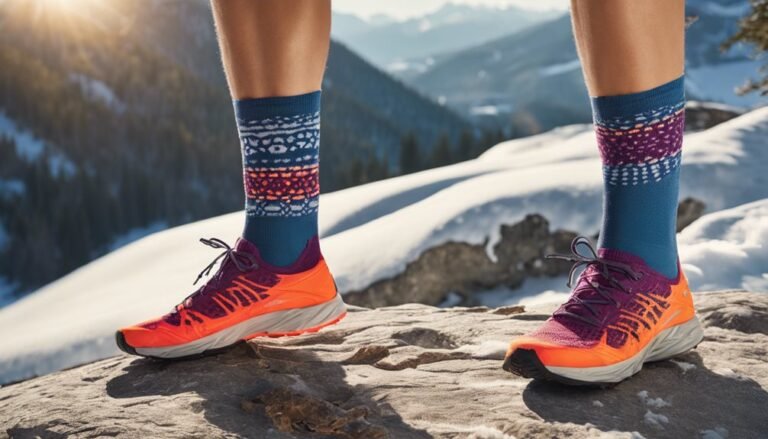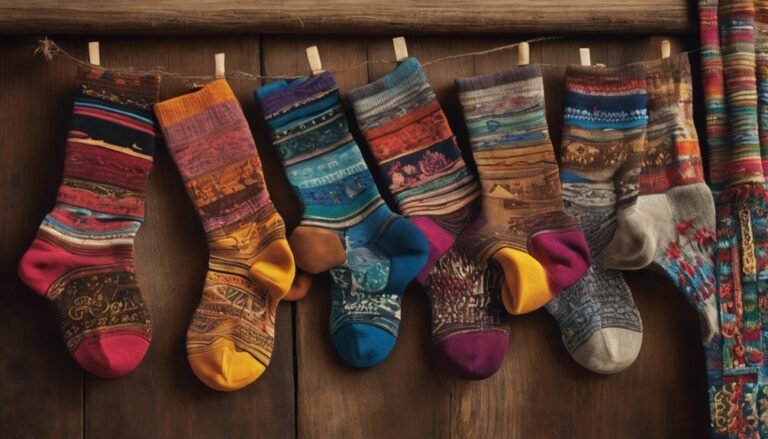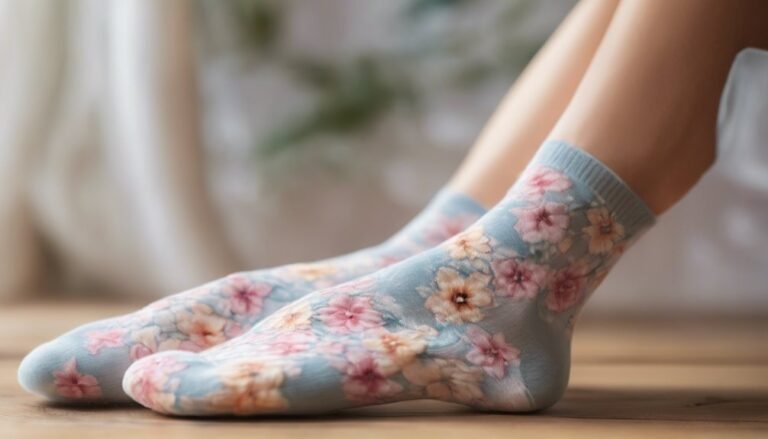Indoor Socks vs. Outdoor Socks: Which Provides Better Comfort?
When it comes to comfort, indoor socks shine with their softness and warmth, making them perfect for cozy lounging. They prioritize materials like cotton and merino wool, but may lack breathability. On the other hand, outdoor socks are designed for functionality, featuring moisture-wicking technology and durable materials. They keep your feet dry and comfortable during activities. If you're wondering how to choose between them or what other features matter, continue exploring further.
Understanding Indoor Socks: Materials and Design

When it comes to comfort at home, indoor socks play an essential role. Your fabric choices greatly influence both the feel and functionality of these socks. Common materials like cotton, bamboo, and merino wool offer breathability and softness, making them ideal for lounging. Each fabric brings unique properties; for instance, bamboo is moisture-wicking, while merino wool provides temperature regulation.
Design elements also matter; look for features like reinforced heels and toes for durability, arch support for comfort, and non-slip grips to prevent slipping on smooth surfaces. The right combination of fabric and design guarantees your indoor socks not only keep your feet cozy but also allow you the freedom to move effortlessly around your home. Prioritize these aspects when selecting your perfect pair.
The Comfort Factor: Softness and Warmth
While you might not think about it often, the softness and warmth of indoor socks greatly enhance your overall comfort. When considering a softness comparison, indoor socks typically feature materials like fleece or bamboo, which provide a plush feel against your skin. These fabrics not only deliver superior softness but also contribute to warmth retention, keeping your feet cozy without overheating. The right indoor socks guarantee that you can lounge freely, enjoying a snug embrace that promotes relaxation. This combination of softness and warmth is essential for unwinding after a long day. Choosing the right pair allows you to experience comfort that enhances your lifestyle, giving you the freedom to enjoy your time indoors to the fullest.
Exploring Outdoor Socks: Features and Functionality
When choosing outdoor socks, you'll want to take into account moisture-wicking technology, which helps keep your feet dry and comfortable during activities. Additionally, the right cushioning and support can prevent fatigue and blisters on long hikes. Finally, durability and weather resistance are essential to guarantee your socks withstand various outdoor conditions while maintaining performance.
Moisture-Wicking Technology
Moisture-wicking technology is essential for outdoor socks, as it actively draws sweat away from your skin to keep your feet dry and comfortable during vigorous activities. This advanced feature enhances moisture management and sweat absorption, allowing you to focus on your adventure without the distraction of damp socks.
| Feature | Description | Benefits |
|---|---|---|
| Fabric Type | Synthetic blends (e.g., polyester) | Quick drying |
| Moisture Control | Hydrophobic fibers | Enhanced sweat absorption |
| Breathability | Mesh panels or ventilation zones | Keeps feet cool |
| Fit | Compression styles | Reduces blisters |
| Odor Resistance | Antimicrobial treatments | Freshness over long hikes |
Choosing outdoor socks with moisture-wicking technology guarantees your feet stay comfortable and free, allowing you to enjoy every step.
Cushioning and Support
Cushioning and support are critical components of outdoor socks, designed to enhance comfort during extended wear. The choice of cushioning materials—like EVA foam or gel inserts—provides shock absorption, reducing fatigue on rugged terrains. These materials help distribute pressure evenly across your foot, ensuring you can traverse various landscapes without discomfort. Support levels vary among different models, with some featuring arch support or reinforced heel and toe areas, which stabilize your foot during dynamic movements. Look for outdoor socks that offer targeted cushioning in high-impact zones, as this can markedly improve your overall experience. By prioritizing proper cushioning and support, you'll find yourself free to explore the great outdoors without the distraction of foot pain or discomfort.
Durability and Weather Resistance
Although you might prioritize comfort when choosing socks for outdoor activities, durability and weather resistance are equally essential. Outdoor socks are designed to withstand the rigors of nature, featuring advanced materials that enhance material strength and protect against the elements. Look for socks with reinforced seams and moisture-wicking properties to keep your feet dry and reduce wear over time.
| Feature | Description | Benefits |
|---|---|---|
| Weather Resistance | Waterproof or water-repellent fabrics | Keeps feet dry in wet conditions |
| Material Strength | High-denier nylon or merino wool | Increased durability and longevity |
| Breathability | Mesh zones for airflow | Regulates temperature and moisture |
Moisture-Wicking Properties in Outdoor Socks

When you're venturing outdoors, the type of socks you wear can greatly impact your comfort and performance, particularly in relation to moisture management. Outdoor socks are typically crafted from breathable fabrics like merino wool or synthetic blends that effectively wick away moisture. This advanced moisture-wicking technology pulls sweat away from your skin, helping to keep your feet dry and reducing the risk of blisters. By maintaining a comfortable microclimate, these socks enhance your overall experience during physical activities. Additionally, the breathability of the fabrics allows for improved air circulation, which is essential in hot or humid conditions. Choosing outdoor socks with these moisture-wicking properties is vital for any adventurer seeking freedom and comfort in the great outdoors.
Cushioning and Support: The Role of Padding
When choosing socks, the type of padding substantially influences your comfort levels. Indoor socks typically feature lighter cushioning for breathability, while outdoor socks employ thicker padding to absorb impact during physical activities. Understanding these differences can help you select the right sock for your specific needs.
Types of Sock Padding
Sock padding plays an essential role in enhancing both comfort and support, particularly when choosing between indoor and outdoor socks. The right sock thickness and cushioning materials can greatly affect your experience. Here are three types of sock padding to evaluate:
- Lightweight Padding: Ideal for indoor socks, it offers a barely-there feel, perfect for lounging.
- Medium Padding: A versatile choice, this thickness provides a balance of comfort and support for everyday wear.
- Heavy Padding: Best for outdoor socks, it absorbs impact and reduces fatigue during rigorous activities.
Impact on Comfort Levels
Although many might overlook the significance of padding in socks, it directly influences your comfort levels during wear. The cushioning provided by sock thickness can considerably enhance your overall experience, especially during prolonged use. If you prefer a softer feel, thicker padding can reduce impact and provide better shock absorption, making it ideal for outdoor activities. Conversely, if you're leaning towards breathability and freedom of movement, thinner indoor socks might suit your comfort preferences. The right balance of padding and support not only prevents blisters but also promotes proper foot alignment. Ultimately, choosing the right sock thickness tailored to your activities guarantees that you enjoy the best comfort, allowing you to focus on your pursuits without distraction.
Temperature Regulation: Indoor vs. Outdoor
While you might not think about it, the type of socks you wear can greatly impact your body's temperature regulation. Indoor socks are designed for the indoor climate, offering insulation and moisture-wicking properties that help maintain comfort. On the other hand, outdoor socks are built to withstand temperature extremes, providing breathability and cushioning for varied terrains.
Consider these factors:
- Insulation: Indoor socks trap warmth, ideal for cozy environments.
- Moisture Management: Outdoor socks keep your feet dry during physical activities.
- Breathability: Outdoor options allow airflow, preventing overheating during exertion.
Choosing the right socks is essential for feeling good in any environment, ensuring your freedom to move comfortably, regardless of the setting.
Durability and Longevity: Which Lasts Longer?
When considering your sock choices, durability plays a significant role in their overall value and performance. Indoor socks typically use softer materials like cotton or bamboo, prioritizing comfort but sacrificing longevity. On the other hand, outdoor socks often incorporate synthetic fibers, such as nylon or polyester, designed to withstand rigorous activities and environmental factors.
Wear testing reveals that outdoor socks endure more abrasion and moisture exposure, making them ideal for extended use. The choice of sock materials directly influences durability; for instance, reinforced heels and toes enhance resilience. If you seek socks that will last through countless adventures, outdoor options are your best bet. Ultimately, knowing what materials suit your lifestyle can guarantee you get the durability you need.
Style and Versatility: Fashion Meets Function

Choosing the right socks isn't just about comfort and durability; it also involves evaluating style and versatility. With the right pair, you can elevate your wardrobe while enjoying freedom of movement. Here are three key points to reflect on:
- Style Trends: Socks are no longer just functional; they're a fashion statement, reflecting current trends.
- Seasonal Choices: Different materials and patterns allow you to adapt your sock game to seasonal changes, ensuring you stay stylish year-round.
- Versatility: A good pair can shift from casual to formal settings, making them a practical choice for every occasion.
Choosing the Right Sock for Your Activity
Understanding the right sock for your activity can greatly enhance both performance and comfort. When selecting socks, consider activity suitability and the specific demands it places on your feet. For high-impact sports, opt for moisture-wicking materials that reduce friction and prevent blisters. Compression socks can improve blood circulation during endurance activities. For casual wear, choose cushioned indoor socks that provide warmth and comfort without constriction.
Apply these sock selection tips: guarantee a proper fit, check for arch support, and consider the terrain you'll encounter. Outdoor activities may require thicker, reinforced socks for durability, while indoor activities might prioritize softness. Ultimately, aligning your sock choice with your activity will empower your freedom to move comfortably and confidently.
Frequently Asked Questions
Can Indoor Socks Be Worn Outdoors Occasionally?
Yes, you can occasionally wear indoor socks outdoors. They often offer style flexibility and comfort but may lack the durability needed for vigorous outdoor activities. Choose wisely based on your specific needs and environment.
Are Outdoor Socks Suitable for Indoor Use?
If you wear outdoor socks indoors, you might notice varying comfort levels due to material differences. While they're durable, their thicker fabric may not provide the softness you'd expect for lounging around your home.
How Do Sock Sizes Differ Between Indoor and Outdoor Options?
Sock sizing often varies between indoor and outdoor options, reflecting different comfort factors. Indoor socks usually prioritize snug fits for warmth, while outdoor socks may offer larger sizes for added cushioning and breathability during activity.
Do Specific Brands Excel in Indoor or Outdoor Sock Comfort?
Imagine your feet cradled in clouds; brand comparisons reveal that certain outdoor brands, like Smartwool, often boast higher comfort ratings, while indoor options, like Bombas, provide a cozy embrace, perfect for lounging and relaxation.
What Are the Environmental Impacts of Manufacturing Indoor vs. Outdoor Socks?
When considering environmental impacts, you'll find that sustainability practices and material sourcing greatly differ. Indoor socks often use synthetic materials, while outdoor socks may prioritize natural fibers, affecting their ecological footprint and overall sustainability.







